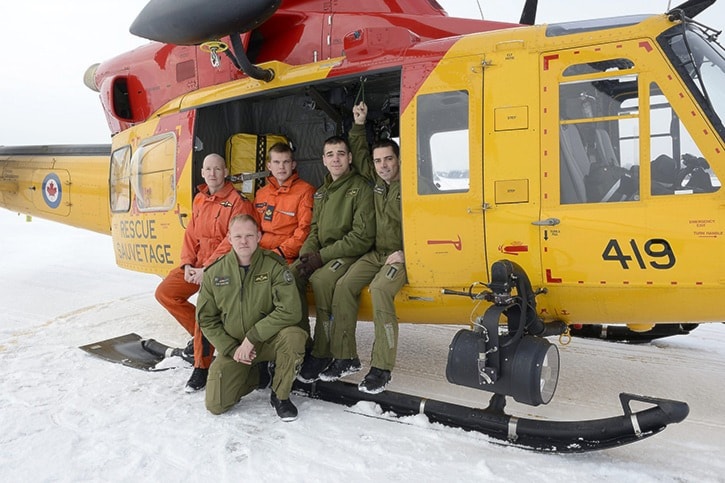The pilot of a military helicopter that rescued a fire-stranded crane operator in Kingston, Ont. last week still calls White Rock ‘home.’
Capt. David Agnew, 38, piloted the Griffon helicopter from CFB Trenton as part of a rescue team whose members became instant media celebrities following the dramatic operation that plucked Adam Jastrzebski from danger on Dec. 17.
While Agnew, wife Tara and their three young children currently live in Ontario, his mother and father, retired firefighter Glenn Agnew, live in White Rock.
“Once a year I go back and see a few buddies from school,” said Agnew, who acknowledged that the direction of his own career as a pilot – and his desire to ‘give back’ through search-and-rescue missions – was heavily influenced by a tragic small plane accident outside Nelson, B.C. from which he, himself, was rescued in 1996.
In last week’s incident, Jastrzebski, 68, had been clinging to a small platform on his crane’s boom for nearly an hour after flames from an under-construction student-housing project for nearby Queen’s University forced him to flee his cab.
While Agnew kept the helicopter hovering close to the crane, which was being compromised by extreme heat from the fire below, search-and-rescue technician Sgt. Cory Cisyk was lowered to the boom and fit the stranded operator into a harness.
Jastrzebski was then transported by helicopter to hospital, where he was recovering from burns to his hands, legs, back and buttocks.
Agnew, a Semiahmoo Secondary and UVic alumnus who studied to become a commercial pilot through Fraser Valley University in conjunction with Coastal Pacific Aviation, has been a military pilot for 15 years, the last five in search and rescue.
Last week’s operation was unusual he said, since most search-and-rescue jobs for his squadron involve boats and wilderness in the Great Lakes area.
“I’d never done an urban rescue before,” he said. “It was higher up than we usually are, so a little harder to control, but definitely easier than a moving boat. The biggest challenge for us was beating time – to get there as fast as possible. We weren’t sure whether the crane was going to collapse.”
Agnew gave kudos to the Kingston Fire Department for keeping the temperature of the crane down by dousing it with water until they could get there, and for keeping flames under control and away from a nearby gas station.
“They’re there for over an hour soaking wet, and we show up for five minutes and get all the credit,” he said, also giving recognition to the other members of the 424 Squadron rescue team, which included co-pilot Capt. Jean-Benoit Girard-Beauseigle, M-Cpl. Matt Davidson, and flight engineer Cpl. Iain Cleaton.
In the 1996 accident that inspired his own career path, the small plane in which Agnew was flying crashed in a deceptively steep valley north of Kokanee Glacier National Park near Nelson. His cousins, Jordan Lefley (then 16) and Trevor Chambers, 10, were with him on the flight, and, in spite of Agnew’s efforts to save Chambers from the burning wreckage, he did not survive the crash.
Lefley had a fractured back and internal injuries. According to a Peace Arch News story at the time, Agnew – who suffered extensive burns – did what he could to keep Lefley comfortable, and rewired the plane’s emergency locator, during the 30 hours before they were rescued.
Agnew said it took a long time for him to come to terms with what had happened, and that it undeniably led him to want to use his flying skills to help others, he said.
“If something good can come of it – that’s the best way to look at it.”
